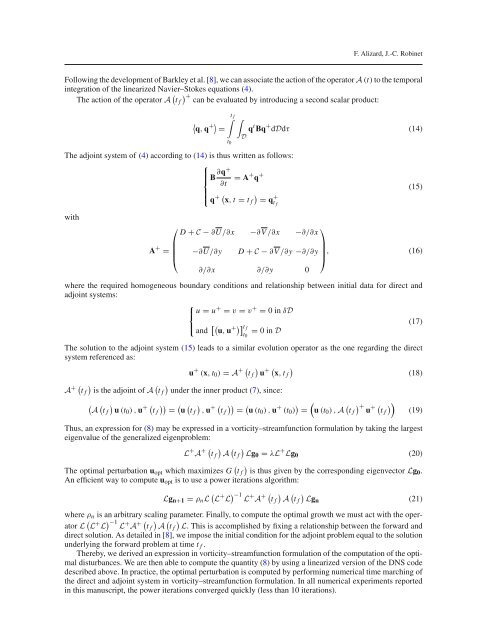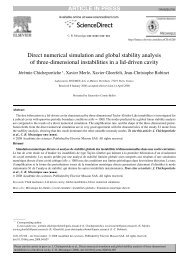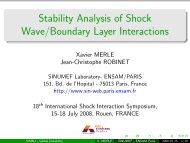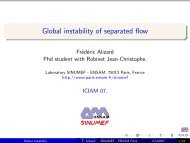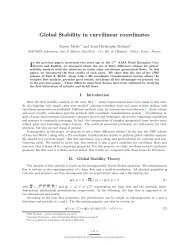Modeling of optimal perturbations in flat plate boundary ... - Ensam
Modeling of optimal perturbations in flat plate boundary ... - Ensam
Modeling of optimal perturbations in flat plate boundary ... - Ensam
Create successful ePaper yourself
Turn your PDF publications into a flip-book with our unique Google optimized e-Paper software.
F. Alizard, J.-C. Rob<strong>in</strong>etFollow<strong>in</strong>g the development <strong>of</strong> Barkley et al. [8], we can associate the action <strong>of</strong> the operator A (t) to the temporal<strong>in</strong>tegration <strong>of</strong> the l<strong>in</strong>earized Navier–Stokes equations (4).The action <strong>of</strong> the operator A ( t f) + can be evaluated by <strong>in</strong>troduc<strong>in</strong>g a second scalar product:〈q, q+ 〉 =∫ t ft 0∫Dq t Bq + dDdτ (14)The adjo<strong>in</strong>t system <strong>of</strong> (4) accord<strong>in</strong>g to (14) is thus written as follows:⎧⎪⎨ B ∂q+ = A + q +∂t⎪⎩ q + ( (15))x, t = t f = q+t fwith⎛⎞D + C − ∂U/∂x −∂V /∂x −∂/∂xA + = ⎜ −∂U/∂y D + C − ∂V /∂y −∂/∂y ⎟⎝⎠ , (16)∂/∂x ∂/∂y 0where the required homogeneous <strong>boundary</strong> conditions and relationship between <strong>in</strong>itial data for direct andadjo<strong>in</strong>t systems:⎧⎨ u = u + = v = v + = 0<strong>in</strong>δD⎩and [( u, u +)] t ft 0= 0<strong>in</strong>DThe solution to the adjo<strong>in</strong>t system (15) leads to a similar evolution operator as the one regard<strong>in</strong>g the directsystem referenced as:u + (x, t 0 ) = A + ( t f)u+ ( x, t f)(18)A + ( ) ( )t f is the adjo<strong>in</strong>t <strong>of</strong> A t f under the <strong>in</strong>ner product (7), s<strong>in</strong>ce:( ( )A t f u (t0 ) , u + ( )) ( ( )t f = u t f , u+ ( )) (t f = u (t0 ) , u + (t 0 ) ) =(17)(u (t 0 ) , A ( t f) + u+ ( t f) ) (19)Thus, an expression for (8) may be expressed <strong>in</strong> a vorticity–streamfunction formulation by tak<strong>in</strong>g the largesteigenvalue <strong>of</strong> the generalized eigenproblem:L + A + ( t f)A(t f)Lg0 = λL + Lg 0 (20)The <strong>optimal</strong> perturbation u opt which maximizes G ( t f)is thus given by the correspond<strong>in</strong>g eigenvector Lg0 .An efficient way to compute u opt is to use a power iterations algorithm:Lg n+1 = ρ n L ( L + L ) −1 L + A + ( t f)A(t f)Lgn (21)where ρ n is an arbitrary scal<strong>in</strong>g parameter. F<strong>in</strong>ally, to compute the <strong>optimal</strong> growth we must act with the operatorL ( L + L ) −1 L + A + ( t f)A(t f)L. This is accomplished by fix<strong>in</strong>g a relationship between the forward anddirect solution. As detailed <strong>in</strong> [8], we impose the <strong>in</strong>itial condition for the adjo<strong>in</strong>t problem equal to the solutionunderly<strong>in</strong>g the forward problem at time t f .Thereby, we derived an expression <strong>in</strong> vorticity–streamfunction formulation <strong>of</strong> the computation <strong>of</strong> the <strong>optimal</strong>disturbances. We are then able to compute the quantity (8) by us<strong>in</strong>g a l<strong>in</strong>earized version <strong>of</strong> the DNS codedescribed above. In practice, the <strong>optimal</strong> perturbation is computed by perform<strong>in</strong>g numerical time march<strong>in</strong>g <strong>of</strong>the direct and adjo<strong>in</strong>t system <strong>in</strong> vorticity–streamfunction formulation. In all numerical experiments reported<strong>in</strong> this manuscript, the power iterations converged quickly (less than 10 iterations).


